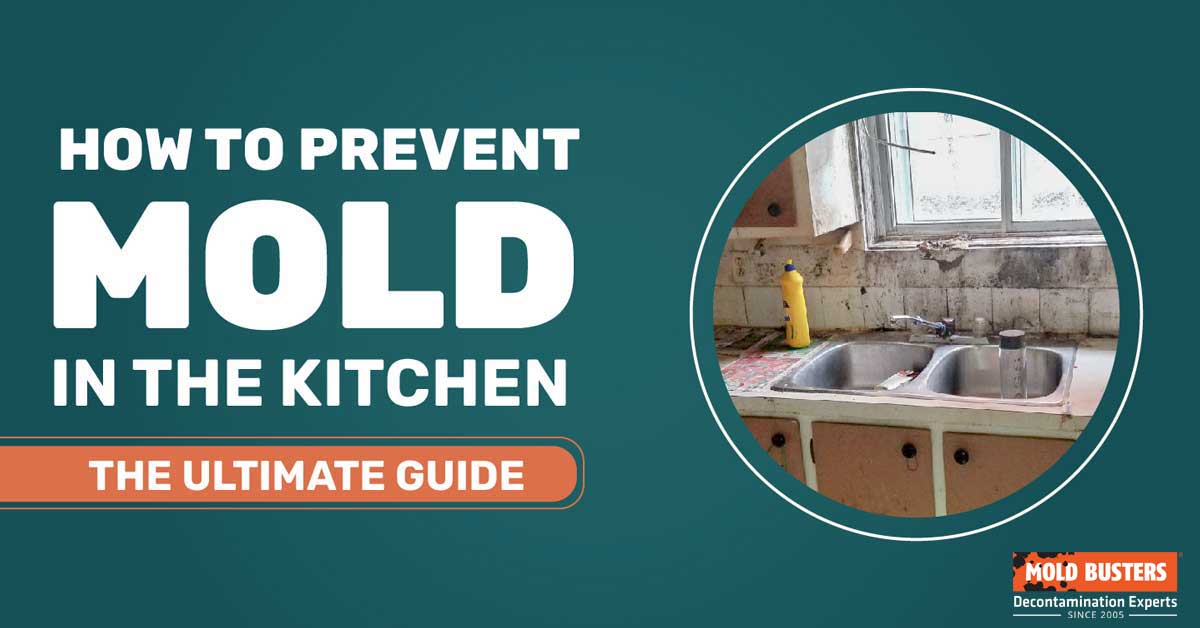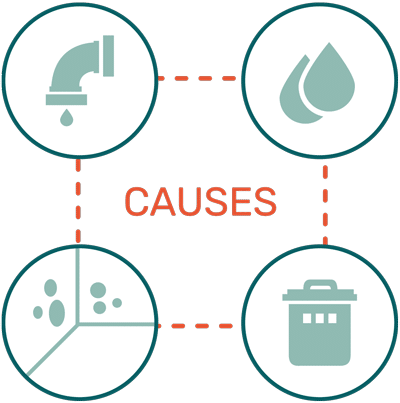How to Prevent Mold in the Kitchen
If there would be a Bermuda triangle of mold in the house, that would definitely be the kitchen, bathroom and basement trio. All three rooms have the honor to be listed here mainly due to the high level of moisture caused by our daily activities. From cooking to taking a shower, everything involving water produces enough moisture for colonies and colonies of mold to grow.
Just like in the bathroom, mold in the kitchen loves wet corners. You should be aware of the surfaces that may be difficult to reach, which have the right conditions for mold to grow. Walls, windows, the tops of kitchen cupboards, and areas that come into contact with moisture, are all potential mold danger spots, so it’s important to ensure that these spots are cleaned and checked regularly.

The main problem with mold in the kitchen is that it can grow almost anywhere, including on your food and in food storage such as refrigerators. It is therefore very important to take special care to prevent mold in the kitchen and, at the same time protect the health of your family, and of course, your own.
Worried About Mold in Your Kitchen? Get a Free Inspection!
Mold in the kitchen can grow almost anywhere and pose serious health risks. Don’t let it go unchecked! Contact Mold Busters for a free virtual mold inspection. Our experts provide a comprehensive assessment and a plan to tackle any mold issue, ensuring your home is safe and healthy. Act now to protect your space!
Common causes of kitchen mold
Understanding what causes mold in the kitchen is the best way to prevent mold from invading. With enough relevant knowledge, you will know where to look for signs of mold and what you can do to protect those places from mold.
Water leaks, dampness and humidity
Water leaks are a common cause of mold (and mildew), as they provide one of the most important growth sources for mold – moisture.
A leaking kitchen sink can create the perfect conditions for mold growth, and mold can in fact be found even at the bottom and under a kitchen sink.
Along with water leaks, damp surfaces and a high level of humidity are also mold triggers. In kitchen areas, the conditions are generally hot and humid, making them a place where both mildew and mold can easily thrive.

Darkness, moisture and supply of food
Mold, as well as mildew, needs a dark place with enough moisture and sufficient nutrients. In these conditions, it takes less than a day for it to grow, so leaving the checking and cleaning until tomorrow can lead to an unpleasant surprise.
Since the kitchen is the place where we keep our food, it is important to understand the risks of decaying food. There is no better organic food source than rotten food, even if it is left in the refrigerator. Mold can survive both cold temperatures in the fridge and hot temperatures in the microwave.

Did you know?
Only 8% of kitchens we have tested didn’t have presence of mold?! Find out more exciting mold stats and facts inside our mold statistics page.
Trash cans and garbage disposals
To see what the perfect conditions for mold growth look like – just open your trash can. It’s moist, dark and there are enough food sources for a mold colony to spread. And all that is due to decaying food.
The same applies to garbage disposals.
Fridge and food storage related mold
If you believe that the temperature in the fridge is too low for mold to grow, and that those dark spots are just bits of dirt, you probably already have fridge-related mold. Old left-over food actually creates the perfect conditions for mold to grow.
High temperature changes (e.g. from frequently opening the fridge door) will create enough moisture for mold to grow in. An additional problem is that behind the fridge, the hot and humid conditions are also perfect for mold growth.

On the top of that, any place where food is stored is actually the perfect place for mold to grow, as it will start growing on food and spread spores easily through the air, into the whole storage.
Kitchen tools and appliances
While on the subject of kitchen equipment, we shouldn’t forget kitchen tools and appliances used daily in preparing food. These are also surfaces for possible mold growth and therefore require special attention and care after each use. Wooden cutting boards and any other wooden tools (e.g. spoons) will provide mold with enough food to grow and spread quicker than you may think.
The conclusion is that almost any spot in your kitchen is a chance for mold to grow, if not taken care of. That’s why it is very important to adapt your daily activities and perform regular checks to prevent mold from growing in the kitchen.
Creating a mold resistant kitchen
If your kitchen is still mold free, well done! You have mastered the prevention mold level of the game. But, in case you have spotted mold (and it is not on food, which we encourage you to throw away immediately), grab your phone and call professionals to perform the initial mold test and determine whether it is really mold and what type you are dealing with.
If you’re in Montreal or Ottawa, our professionals can help with air quality testing and mold inspection.
Keep an eye on humidity levels
We’ve talked about humidity and its impact on mold, and we will keep pointing that out as long as it takes. Since both mold and mildew love high levels of humidity, it’s important to ensure the optimal level that prevents mold from growing and spreading.
The best, and the cheapest, way to deal with a high level of humidity in your home is to open your windows regularly and keep them open as long as possible. To prevent heat loss during the winter, instead of opening just one window, open several at once and keep them open for five to ten minutes. Not only will that lower the level of humidity, but it will also allow fresh air to take the place of stale air.
For a more comprehensive solution, consider our virtual inspection service.
During the summer, when the level of humidity is higher due to heat (and especially if you live in a highly humid climate), the best way to deal with the humidity problem is to add dehumidifiers. Perform the initial air test to find out the current humidity levels, after which you can adjust your dehumidifiers according to the results you get. Be aware of low humidity levels, as they can have an impact on your health. Although mold will not grow in such conditions, you may develop dry skin, lips and hair, a scratchy throat and itchy nose, etc.
Pay attention to windows and walls as they are the usual target for mold. To prevent mold in the kitchen, or in any other room, you can always use mold-resistant paint. As an additional precaution, minimize the amount of carpeting as much as possible, since that is also the perfect place for mold to settle in.
Our mold testing service can help identify potential sources of mold in your kitchen.
Turn the stove fan on when cooking!
A high level of humidity in the kitchen is often due to the steam which comes from preparing food. We can blame both cooking and boiling water for mold in the kitchen. That’s why controlling the humidity level and doing some small additional things during food preparation is the quickest way to prevent mold in kitchen.
Each time you cook something on the stove, make sure to turn on the kitchen vent. If you don’t have one, opening windows can be just as good, or even better. In case you are using a kitchen vent, make sure that the steam and odor go directly out of your home.
Periodically check for leaks
We’ve mentioned earlier that mold loves any type of moisture. Although humidity is often the main source, it is important to keep in mind that water leaks and flooding also favor mold. It is good to perform regular pipe checks to ensure that there are no leaks, or if there are, to take care of them immediately.
If you have a dishwashing machine, don’t forget to check it too. Take it out and thoroughly clean and remove any water you may notice.
Clean your kitchen regularly
Mold loves organic food sources, whether they come from rotten food or from dust and dirt. It can grow in your kitchen from food dropped not only in visible places, but also in out of sight places, such as behind the oven and the refrigerator.
Although there is no way to prevent food from dropping on the floor, especially in a shared kitchen, you can prevent mold from growing by cleaning everything top to bottom at least once a month. That includes not only washing dishes but ensuring that there is no food between the counter, fridge and any other piece of furniture or appliances.
If you notice any food or water spots, don’t delay moving the furniture, as mold can start a colony in about 24 hours. You can always rely on mold prevention sprays, but don’t forget that they will not last forever.
Clean the cabinets and food storage areas
While you are washing your dishes, pay close attention to your kitchen cabinets and food storage areas before you put the dishes back, as mold can often be found there. Take all the stored dishes out and simply wipe everything. Before you start putting the dishes back, ensure your cabinets are dry.
Degrease kitchen cabinets and perform a thorough check of your food storage areas. Throw away anything spoiled or moldy and inspect if there is mold inside the food storage. In order to prevent mold from growing, make sure you use the food you buy before it gets moldy.
Don’t forget to clean your fridge too! Even though you might think that mold cannot live in the fridge due to cold, it actually can and will live in your fridge if there is enough moisture and food sources (and we all know fridge is full of both).
Throw away spoiled food
Spoiled fruit and vegetables are a breeding ground for mold. That’s why you should be cleaning your food storage and leftovers from spoiled food almost daily. The best way to prevent mold on food is to prevent food from rotting in the first place. If you notice that you often throw away fruit or veggies, try and find out why. Do you buy too much or do you eat very little? Not only will you make an impact on mold prevention, but you will also take a good look at your eating habits and budget.
It’s not unusual to simply forget about the food we keep in the fridge. That is why it’s important to check the bottom drawer of your fridge regularly, to ensure that there are no moldy food leftovers.
Clean appliances after use
Moisture and a food source – that’s how mold sees your kitchen each time you use any of the kitchen appliances, and that’s why you should keep them clean, after each use. And we do mean after each use.
Blenders, coffee pots and microwaves can be easily wiped and washed. You may think that microwave radiation would kill mold spores, but we have some bad news for you – mold can still form even in the microwave.
The main problem with appliances is that they are sealed, covered or closed when not in use, which actually cuts the air flow and traps the mold spores inside.
To conclude, prevent mold on your kitchen appliances by cleaning them after each use and ensuring that they are well dried before putting them away.
Our mold inspection services in Montreal include a thorough check of your kitchen appliances and more.
Run your garbage disposal daily and empty your trash can
Mold loves both garbage disposals and trash cans and since it can grow within hours, it is very important to take care of them on a daily basis to prevent mold from growing. Run your disposal and empty your trash can at least once a day (even more often if needed).
Pour vinegar down your garbage disposal once a month to kill bacteria. To keep your trash can clean, wash it once a week with detergent and leave it outside (preferably), to dry before putting it back in use. To keep it cleaner for a longer time, use trash bags and ensure that they are properly placed so that no food touches the inside of the trash can besides the lid.
Wash dishes daily
Piled up dishes in the sink will build a mold colony as well. When dishes are stacked, they are often unable to dry, and by now you know very well the results of moisture and rotten food. On top of that, both rotten food and moisture will attract more visitors than just mold.
When doing the dishes, wooden ones such as cutting boards and spoons should be cleaned immediately after use and left out to dry. At the same time, ensure that each piece is well dried before putting it into a cabinet, as it may be to blame for spreading mold.
In case you’ve spotted any dark circles during your kitchen mold check, grab your phone and call professionals to determine if it is mold or mildew, and properly treat it to prevent it from growing back. Consider our mold removal services if you’re dealing with a serious mold issue in your kitchen. Don’t forget, it’s not mold until tested.

Get Special Gift: Industry-Standard Mold Removal Guidelines
Download the industry-standard guidelines that Mold Busters use in their own mold removal services, including news, tips and special offers:
Published: August 21, 2018 Updated: June 27, 2024

Written by:
John Ward
Account Executive
Mold Busters
Fact checked by:
Michael Golubev
CEO
Mold Busters
